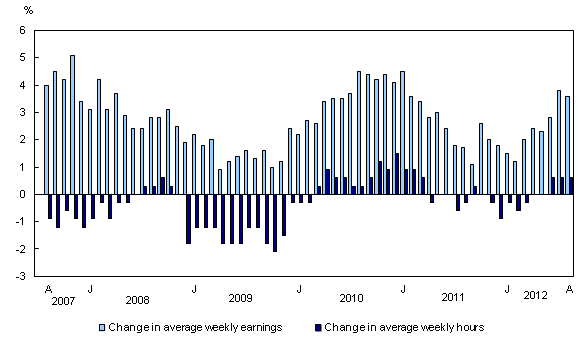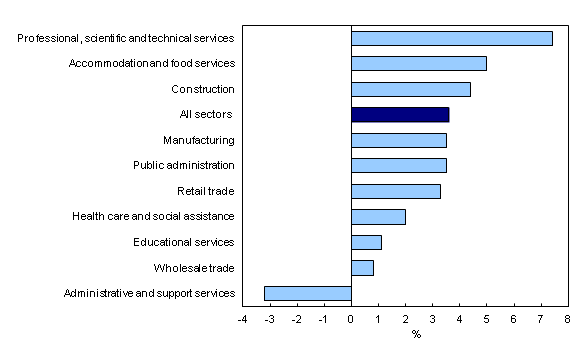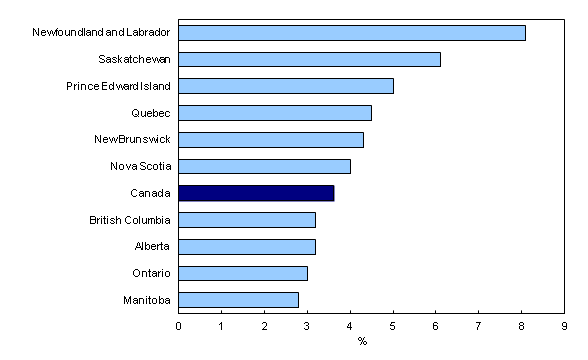Payroll employment, earnings and hours, August 2012
Archived Content
Information identified as archived is provided for reference, research or recordkeeping purposes. It is not subject to the Government of Canada Web Standards and has not been altered or updated since it was archived. Please "contact us" to request a format other than those available.
Related subjects
-
[an error occurred while processing this directive]
In August, average weekly earnings of non-farm payroll employees were $907.19, up 0.4% from the previous month. On a year-over-year basis, earnings increased 3.6%.
Year-over-year change in average weekly hours and average weekly earnings

Chart description: Year-over-year change in average weekly hours and average weekly earnings
The 3.6% earnings' increase during the 12 months to August reflects a number of factors, including wage growth, changes in the composition of employment by industry, occupation and level of job experience, as well as average hours worked per week. In August, non-farm payroll employees worked an average of 33.1 hours per week, up from 33.0 the month before and 32.9 in August 2011.
Average weekly earnings by sector
Year-over-year growth in average weekly earnings outpaced the national average of 3.6% in three of the largest industrial sectors: professional, scientific and technical services; accommodation and food services; and construction. Earnings in administrative and support services declined between August 2011 and August 2012.
Year-over-year change in average weekly earnings in the 10 largest sectors, August 2011 to August 2012

Weekly earnings in professional, scientific and technical services rose 7.4% to $1,273.60, with gains in almost all industries within the sector.
Weekly earnings in accommodation and food services increased 5.0% to $374.54 in the 12 months to August. Growth was most notable in special food services, limited-service eating places and traveller accommodation. Payroll earnings in this sector were the lowest among all sectors, partly because it had the lowest weekly hours.
In construction, weekly earnings rose 4.4% to $1,144.43, with notable growth in non-residential building construction; highway, street and bridge construction; and building finishing contracting.
Average weekly earnings in administrative and support services declined 3.2% to $724.03, mostly in employment services.
Average weekly earnings up in every province
Average weekly earnings of non-farm payroll employees increased in every province in the 12 months to August. Growth was notably above the national average in Newfoundland and Labrador and Saskatchewan.
Year-over-year growth in average weekly earnings by province, August 2011 to August 2012

In Newfoundland and Labrador, average weekly earnings were $942.31 in August, up 8.1% from 12 months earlier. This was the third consecutive year-over-year increase above 6%. Weekly earnings in the province are among the highest in the country.
In Saskatchewan, average weekly earnings increased 6.1% in the 12 months to August, to $938.57, and were also among the highest in the country. Earnings in the province have been higher than the national average since August 2011.
Average weekly earnings in Prince Edward Island were $761.13 in August, up 5.0% compared with 12 months earlier. Year-over-year increases in earnings for this province have been at or above the national average since the start of 2012.
In Quebec, average weekly earnings amounted to $829.55 in August, up 4.5% from 12 months earlier.
Average weekly earnings remained the highest of all provinces in Alberta, at $1,084.26 in August. On a year-over-year basis, earnings increased 3.2% in the province, just under the national average.
Weekly earnings in Ontario grew 3.0% to $919.05, the fourth-highest earnings level in Canada. Year-over-year growth in Ontario has been below the national average since October 2010.
Non-farm payroll employment by sector
Total non-farm payroll employment rose by 45,500 between July and August, the sixth consecutive monthly increase.
In August, payroll employment increased in most sectors, including educational services; public administration; manufacturing; health care and social assistance; and mining, quarrying and oil and gas extraction.
On a year-over-year basis, payroll employment rose by 316,000 (+2.1%), with most of these gains occurring since February 2012 (+285,100).
Among all sectors, mining, quarrying, and oil and gas extraction continued to post the highest 12-month growth rate in payroll employment, at 10.7% in August. It was followed by construction (+5.3%); accommodation and food services (+3.2%); professional, scientific and technical services (+2.7%); and transportation and warehousing (+2.7%).
Note to readers
The Survey of Employment, Payrolls and Hours (SEPH) is a business census of non-farm payroll employees. Its key objective is to provide a monthly portrait of the level of earnings, the number of jobs and hours worked by detailed industry at the national, provincial and territorial level.
Statistics Canada also produces employment estimates from its monthly Labour Force Survey (LFS). The LFS is a household survey, the main objective of which is to divide the working-age population into three mutually exclusive groups: the employed (including the self-employed), unemployed and not in the labour force. This survey is the official source for the unemployment rate and collects data on the socio-demographic characteristics of all those in the labour market.
As a result of conceptual and methodological differences, estimates of changes from SEPH and LFS do differ from time to time. However, the trends in the data are quite similar.
Unless otherwise stated, this release presents seasonally adjusted data, which facilitates comparisons by removing the effects of seasonal variations. For more information on seasonal adjustment, see Seasonal adjustment and identifying economic trends.
Non-farm payroll employment data are for all hourly and salaried employees, as well as the "other employees" category, which includes piece-rate and commission-only employees.
Average weekly hours data are for hourly and salaried employees only and exclude businesses that could not be classified to a North American Industry Classification System (NAICS) code.
All earnings data include overtime pay and exclude businesses that could not be classified to a NAICS code. Earnings data are based on gross payroll before source deductions.
Average weekly earnings are derived by dividing total weekly earnings by the number of employees.
With each release, data for the current reference month are subject to revision. Data have been revised for the previous month. Users are encouraged to request and use the most up-to-date data for each month.
Data on the education sector
Changes in payroll employment in education during the summer months can be affected by changes in payment schedules and school-year calendars. Month-to-month changes in payroll employment should therefore be interpreted with caution, and more attention given to long-term trends.
Available without charge in CANSIM: tables CANSIM table281-0023 to 281-0039 and CANSIM table281-0041 to 281-0049.
Definitions, data sources and methods: survey number survey number2612.
A data table is available from the Key resource module of our website under Summary tables.
Detailed industry data, data by size of enterprise based on employment, and other labour market indicators will soon be available in the monthly publication Employment, Earnings and Hours, Vol. 90, no. 8 (Catalogue number72-002-X, free).
Data on payroll employment, earnings and hours for September will be released on November 28.
For more information, contact us (toll-free 1-800-263-1136; infostats@statcan.gc.ca).
To enquire about the concepts, methods or data quality of this release, contact Jeannine Usalcas (613-951-4720; jeannine.usalcas@statcan.gc.ca), Labour Statistics Division.
- Date modified:
